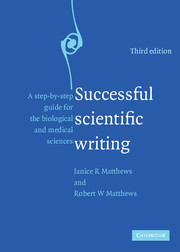Book contents
- Frontmatter
- Contents
- Preface
- Preface to the third edition
- 1 PREPARING TO WRITE
- 2 COMPOSING A FIRST DRAFT
- 3 VISUAL SUPPORT FOR THE WRITTEN WORD
- 4 VISUAL SUPPORT FOR THE SPOKEN WORD
- 5 REVISING TO INCREASE COHERENCE
- 6 IMPROVING WORD CHOICE, AND SYNTAX STYLE
- 7 ATTENDING TO GRAMMAR, NUMBERS, AND OTHER MECHANICS
- 8 THE REST OF THE STORY
- Appendix 1 Suggested responses to exercises
- Appendix 2 Excerpts from “Uniform requirements for manuscripts submitted to biomedical journals: Writing and editing for biomedical publication”
- Selected resources
- Index
8 - THE REST OF THE STORY
- Frontmatter
- Contents
- Preface
- Preface to the third edition
- 1 PREPARING TO WRITE
- 2 COMPOSING A FIRST DRAFT
- 3 VISUAL SUPPORT FOR THE WRITTEN WORD
- 4 VISUAL SUPPORT FOR THE SPOKEN WORD
- 5 REVISING TO INCREASE COHERENCE
- 6 IMPROVING WORD CHOICE, AND SYNTAX STYLE
- 7 ATTENDING TO GRAMMAR, NUMBERS, AND OTHER MECHANICS
- 8 THE REST OF THE STORY
- Appendix 1 Suggested responses to exercises
- Appendix 2 Excerpts from “Uniform requirements for manuscripts submitted to biomedical journals: Writing and editing for biomedical publication”
- Selected resources
- Index
Summary
Never be afraid to try something new. Remember, amateurs built the ark; professionals built the Titanic.
Since 1946, an American newscaster named Paul Harvey has been broadcasting a radio segment called The Rest of the Story. It always begins as a quaint, apparently historical tale about someone that seems very average until the very end, when Harvey dramatically exposes a missing element that reveals the deeper significance hidden within. Then he concludes: “And now you know … the rrrrest of the story!”
You are now at that dramatic moment, ready to share your scientific tale with the world. Only relative details stand between you and scientific publication. We have no way of knowing what will come next in your life, but we are confident that you are on the brink of something great. Go forward with confidence. Soon you will be celebrating, and soon afterward, planning your next project.
PREPARING TO PUBLISH
If you think that something small cannot make a difference, try going to sleep with a mosquito in the room.
You've just finished going through your document for what seems like the hundredth time. Take a break, and get some sleep, then come back to the document one last time. Nine basic questions provide a good framework for a final review of nearly any scientific paper. If any of them cause you problems, refer back to the material in earlier chapters.
- Type
- Chapter
- Information
- Successful Scientific WritingA Step-by-Step Guide for the Biological and Medical Sciences, pp. 182 - 208Publisher: Cambridge University PressPrint publication year: 2007



